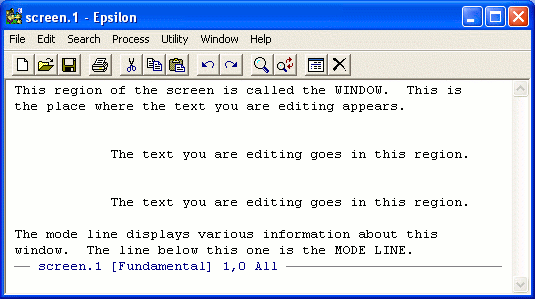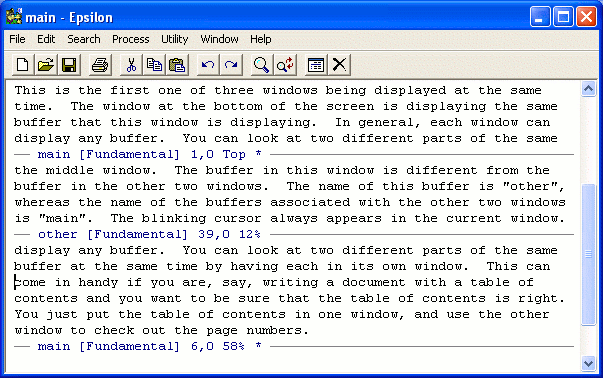Programmer's
Editor 14.01
Context:
| Epsilon User's Manual and Reference |
| . . . |
| Getting Started |
| Windows Installation |
| Unix Installation |
| macOS Installation |
| . . . |
| File Inventory |
| General Concepts |
| Buffer Concepts |
| Window Concepts |
| Epsilon's Screen Layout |
| Modes in Epsilon |
| Binding Commands |
| . . . |
| Commands by Topic |
| Getting Help |
| Moving Around |
| Changing Text |
| . . . |
| Miscellaneous |
| . . . |

| Previous | Up | Next |
| Window Concepts | General Concepts | Modes in Epsilon |
Epsilon User's Manual and Reference > General Concepts >
Epsilon's Screen Layout
To see what buffers and windows look like, refer to the illustration. This shows what the screen looks like with only one window. It shows what the screen looks like when you edit a file named screen.1.

The top section of the screen displays some of the text of the window's buffer. Below that appears the mode line. The mode line begins with the name of the file shown in that buffer. If the buffer isn't associated with any file, Epsilon substitutes the buffer name, in parentheses.
Next comes the name of the current major mode, followed by any minor modes, all surrounded by square brackets. (See Modes in Epsilon.)
Then Epsilon shows the current column and line numbers (the first counting from zero, the second counting from 1), and the percentage of the buffer before the cursor. A star (*) at the end of the line means that you have changed the buffer since the last time you saved it to disk. (See the mode-format variable for information on customizing the contents of the mode line.) The text area and the mode line collectively constitute the window.
Below the mode line, on the last line of the screen, appears the echo area. Epsilon uses this area to prompt you for information or to display messages (in the figure it's empty). For example, the command to read a file into a buffer uses the echo area to ask you for the file name. Regardless of how many windows you have on the screen, the echo area always occupies the bottommost screen line.
When Epsilon displays a message in the echo
area, it also records the message in the #messages# buffer
(except for certain transient messages). See the
message-history-size variable to set how Epsilon keeps the
buffer from excessive size by dropping old messages.
Epsilon has an important concept called the editing point, or simply point. While editing a buffer, the editing point refers to the place that editing "happens", as indicated by the cursor. Point refers not to a character position, but rather to a character boundary, a place between characters. You can think of point as, roughly, the leftmost edge of the cursor. Defining the editing point as a position between characters rather than at a particular character avoids certain ambiguities inherent in the latter definition.
Consider, for example, the command that goes to the end of a word, forward-word. Since point always refers to a position between characters, point moves right after the last letter in the word. So the cursor itself would appear underneath the first character after the word. The command that moves to the beginning of the word, backward-word, positions point right before the first character in the word. In this case, the cursor itself would appear under the first character in the word.
When you want to specify a region, this definition for point avoids whether characters near each end belong to the region, since the ends do not represent characters themselves, but rather character boundaries.

The illustration shows Epsilon with 3 windows. The top window and bottom window each show the buffer "main". Notice that although these two windows display the same buffer, they show different parts of the buffer. The mode line of the top window says 0%, but the mode line of the bottom window says 58%. The middle window displays a different buffer, named "other". If the cursor appears in the middle window and you type regular letters (the letters of your name, for example), they go into the buffer named "other" shown in that window. As you type the letters, the point (and so the cursor) stays to the right of the letters.
In general, the current window refers to the window with the cursor, or the window where the "editing happens". The current buffer refers to the buffer displayed by the current window.
| Previous | Up | Next |
| Window Concepts | General Concepts | Modes in Epsilon |
![]()
![]() Epsilon Programmer's Editor 14.01 manual. Copyright (C) 1984, 2020 by Lugaru Software Ltd. All rights reserved.
Epsilon Programmer's Editor 14.01 manual. Copyright (C) 1984, 2020 by Lugaru Software Ltd. All rights reserved.